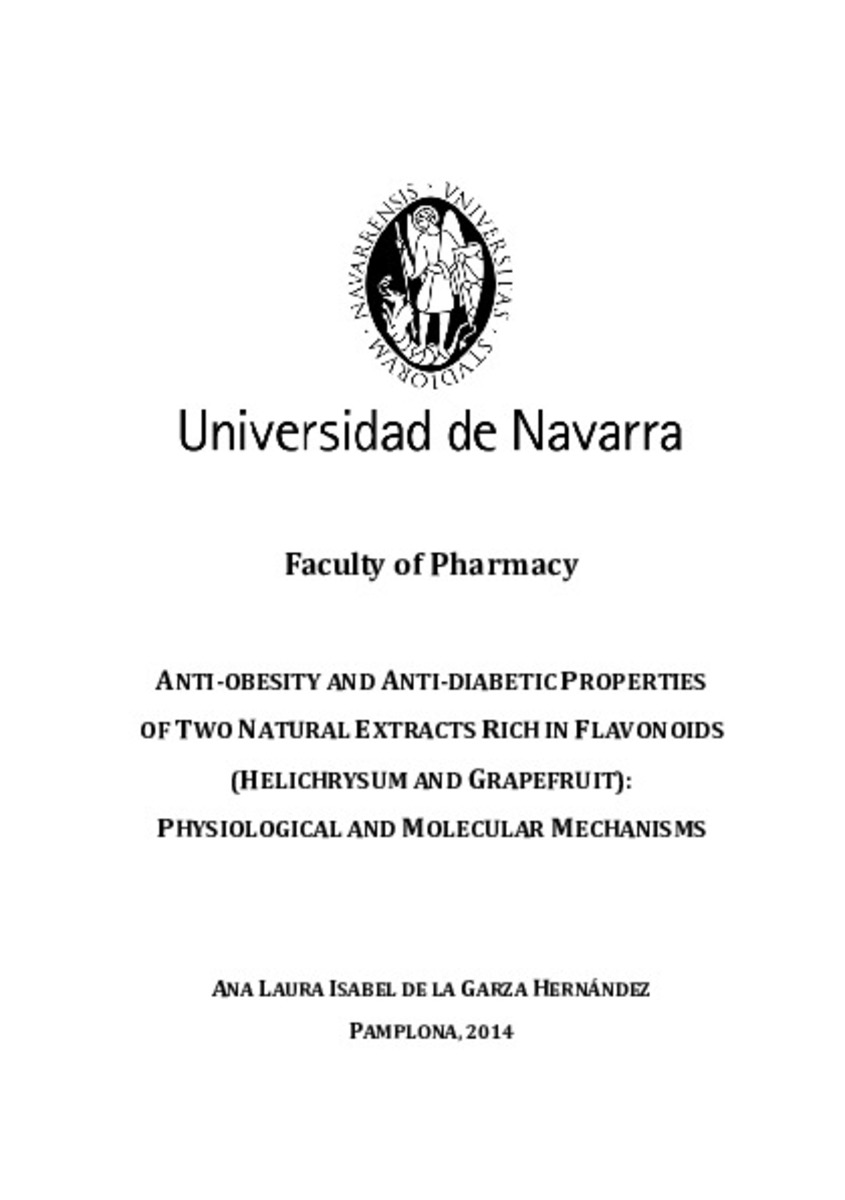Full metadata record
| DC Field | Value | Language |
|---|---|---|
| dc.contributor.advisor | Milagro-Yoldi, F.I. (Fermín Ignacio) | - |
| dc.contributor.advisor | Martinez, J.A. (José Alfredo) | - |
| dc.creator | Garza, A.L. (Ana Laura) de la | - |
| dc.date.accessioned | 2015-07-31T08:24:03Z | - |
| dc.date.available | 2015-07-31T08:24:03Z | - |
| dc.date.issued | 2015 | - |
| dc.date.submitted | 2014-06-27 | - |
| dc.identifier.citation | DE LA GARZA HERNÁNDEZ, Ana Laura. “Anti-obesity and anti-diabetic properties of two natural extracts rich in flavonoids (helichrysum and grapefruit): physiological and molecular mechanisms”. Milagro Yoldi, Fermín I. (dir.), Martínez Hernández, J. Alfredo (codir.). Tesis doctoral. Universidad de Navarra, Pamplona, 2014 | es_ES |
| dc.identifier.uri | https://hdl.handle.net/10171/38824 | - |
| dc.description.abstract | The objective of the current research is the study of the possible beneficial anti-obesity and anti-diabetic effects of two natural extracts derived from helichrysum (Helichysum italicum) and grapefruit (Citrus x paradisi) through in vitro studies and animal models investigations. Obesity and diabetes are two of the biggest emerging health problems worldwide. Obesity is a multifactorial disease usually accompanied by insulin resistance (IR) and an increase in oxidative stress and inflammatory markers. On the other hand, type 2 diabetes mellitus (T2DM) is a metabolic disorder characterized by chronic hyperglycemia as a result of impairments in insulin secretion and insulin action in target tissues. Several plant extracts rich in flavonoids have been reported to improve hyperglycemia by inhibiting digestive enzyme activities and SGLT1-mediated glucose uptake in the gut. Furthermore, flavonoids are widely recognized for biological and pharmacological effects including antioxidant and anti-inflammatory properties. The current work has analyzed the potential role of helichrysum and grapefruit extracts rich in flavonoids as anti-obesity and anti-diabetic agents. In the present research, helichrysum and grapefruit extracts improved postprandial glycemic control in rats, possibly by inhibiting the activities of carbohydrate-digestive enzymes and by decreasing SGLT1-mediated glucose uptake, which may be relevant for the treatment of obesity and T2DM. Furthermore, in a diabetic animal model (db/db mice), helichrysum and grapefruit extracts improved glucose metabolism in liver and the inflammatory status in liver and adipose tissue. Finally, in a model of energy restriction in overweight insulin-resistant rats, anti-inflammatory and antioxidant effects were found for both extracts, which may be associated to their beneficial metabolic effects. In this context and for oncoming studies, once the effectiveness and safety of the helichrysum and grapefruit extracts have been demonstrated, their use might be considered as a supplement and/or food complement or for the design of a functional food focused on weight loss and diabetes management. | es_ES |
| dc.language.iso | eng | es_ES |
| dc.publisher | Servicio de Publicaciones. Universidad de Navarra. | es_ES |
| dc.rights | info:eu-repo/semantics/openAccess | es_ES |
| dc.subject | Digestión | es_ES |
| dc.subject | Fisiología gastrointestinal | es_ES |
| dc.subject | Enfermedades de la nutrición | es_ES |
| dc.title | Anti-obesity and anti-diabetic properties of two natural extracts rich in flavonoids (helichrysum and grapefruit): physiological and molecular mechanisms | es_ES |
| dc.type | info:eu-repo/semantics/doctoralThesis | es_ES |
Files in This Item:
Statistics and impact
Items in Dadun are protected by copyright, with all rights reserved, unless otherwise indicated.






